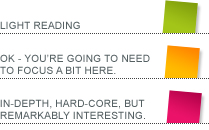The Web 2.0 buzz has been around for quite a while now, but I thought I’d make an attempt to explain just what it is and, more importantly, describe how you can use it practically to fulfil the goals of your website.
As with many buzzwords, the meaning of the term was never really clearly defined to begin with, and over time the meaning has become diluted, as different people use the term to mean different things. Web 2.0 means different things to different people, depending on how they interact with it, but the gist is generally the same.
Web 2.0 describes the movement of sites away from one-dimensional content delivery tools towards two-dimensional interactive social communication tools, which allow and encourage two-way communication and participation by the user, and interaction with other Web 2.0 communities.
To explain the contrast more specifically:
Web 1.0 sites are usually comprised of a collection of content pages organised into a hierarchical structure. The user can browse the content, and gain information about the subject, but their participation is limited to communication directly with the site itself. E-commerce sites, for example, are still considered Web 1.0, no matter how cool and funky they are, or how much AJAX and other effects they use, because the communication, while two-way, is only between the user and the site.
Web 2.0 sites are tools used by members of the internet community to communicate and share ideas. In their most advanced forms (eg: Facebook), the entire purpose of the site is to do this, and there is nothing else to it, but most Web 2.0 sites provide tools which allow the users to share the content with others, and to participate and add or edit the content of the site themselves.
It is important to note that the Web 2.0 concept is not an absolute label; a website is not either 1.0 or 2.0. Until they completely re-design the technology that runs the internet, all websites will be Web 1.0. Some websites will also be described as incorporating Web 2.0 concepts, to one degree or another.
So, how does all this affect you? Should you make your website Web 2.0 and, if so, how, exactly? Well, assuming you don’t have a multi-million dollar budget (and if you do, you should most definitely call me), there are two practical things you can do to with your website to harness the benefits of the Web 2.0 revolution.
Sharing Content
The first, and easiest, thing to do is to provide tools that allow your visitors to share the information they’ve found with their friends / colleagues. All the major social networks provide tools to do this, and there are a number of online services that bring all of this together into one small app (http://sharethis.com or http://www.addthis.com, for example). The number of options is vast, so you should be careful when choosing which networks to offer – offering too many choices will often confuse users, and end up being counterproductive. Pick the three or four mediums you feel your target audience most actively use, and include those.
Audience Participation
One of the core concepts of Web 2.0 is allowing the website users to participate in the process of creating content on the site. Users love to be able to participate, and they feel a definite connection and affinity for sites to which they have contributed. The problem here is that you need to allow people who are not under your control to add content to your website. Scary.
More than scary though, there is the issue of brand identity. It doesn’t matter if you are a large corporation with a “TM” after your name, or a small one-person organisation, your website needs to identify, define and promote your brand. In other words, you’ve chosen a face to present to the world, and your website needs to present that face. This will often include a certain style of communication which is unlikely to be understood or adhered to by users.
There are several solutions to this, but our recommended path is to separate the brand website from the user-participation platform. Or, more simply, use a blog. In this way, your website itself is wholly managed by you, and you have complete control over the content, style, and brand identity it presents. The blog, on the other hand, can be designed to look similar to the website, but with a more interactive feel. Here, you present information in a more informal style, and invite comments from users. You can use information from the website as the basis of your blogs posts, and you can selectively use the content of your blog on your website, so there will be a fair amount of inter-connectivity, but your brand identity is still maintained.
There is a great deal more that can be done to harness the power of the Web 2.0 revolution and the social networking phenomenon it has spawned, to market and grow your business, but that is for another post.
Note from the designer:
Gareth’s spot on here – Web 2.0 has to do with communication and participation. From a design point of view, “web 2.0” was taken to mean a design style – all you needed to do was make a star shape, give it a gradient and some glossy effect and voila – you had designed a web 2.0 site! In fact it was even easier than that – all you had to do was visit a (web 1.0) website and download the stuff. Needless to say, style itself doesn’t make a website 1.0 or 2.0. In fact, this “web 2.0” style is now a bit old fashioned – it’s a bit early 2000’s.



